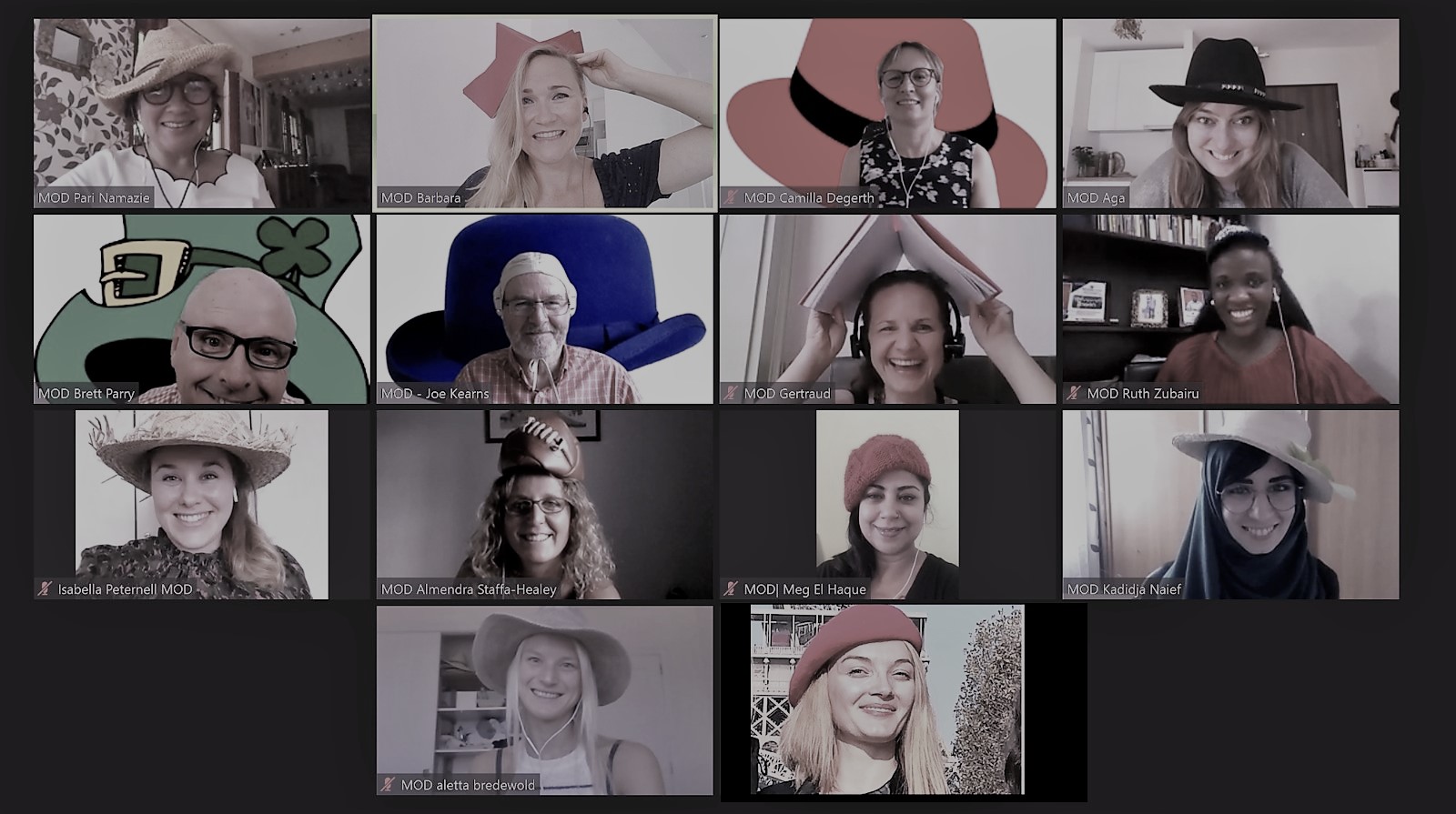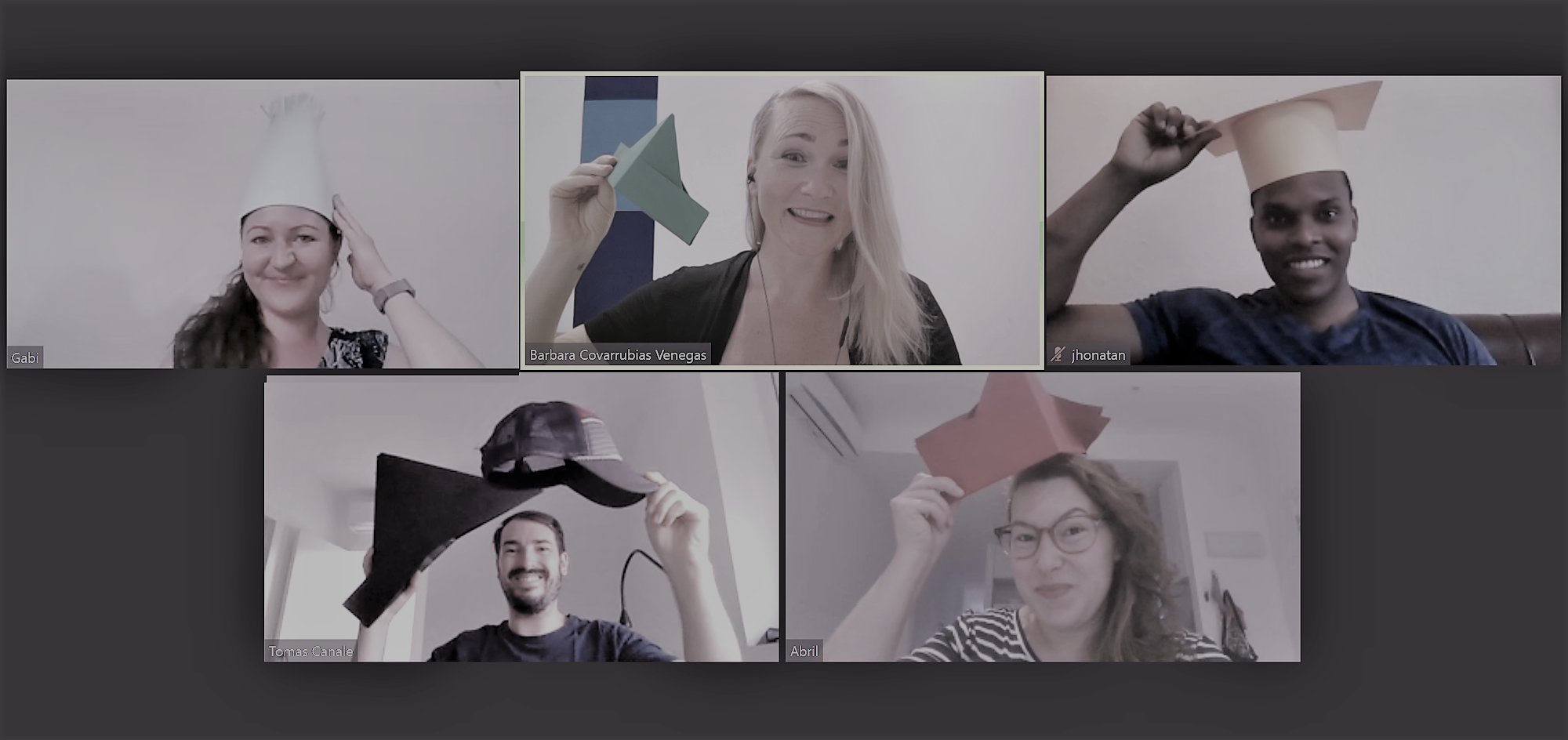During this year’s Summer Academy for Diversity & Innovation we were exploring new methods and innovative approaches to foster creative thinking, new ways to problem-solving – all in order to leverage Diversity for Innovation. The Academy created diverse and inclusive learning spaces enabling the development of collective intelligence and social innovation. We use collaborative methods in the virtual space to foster closeness at a distance and support people in learning from each other across the globe.
How did we come up with the idea of this article?
I had the tremendous pleasure to conduct a Masterclass about “IMPACTFUL online training: how to create an inclusive environment in the virtual space! Besides my own course, I had the great opportunity to participate in Gabriela Weglowska’s Astronaut (Advanced) Level course about “Architecting Intercultural Learning for the Modern Learner”. Gabriela is a Learning & Development professional, passionate about intercultural skills training, diversity & inclusion, as well as brain-friendly and technology-enhanced learning.
One of the activities both of us have been using in different contexts as trainers in the past years is the Six Thinking Hats method from Edward de Bono. However, it was in Gabriela’s course where I first saw the method used in the virtual space. It was a great example of innovation – adapting learning to ‘the new normal’; and so we decided to explore it further. I immediately had the idea to combine the virtual with the physical, meaning to provide the participants with a more tactile experience, adding another layer to the virtual experience. Think about it: the moment we all went virtual almost all of us stopped using physical props to add to the participant’s experience. Often, we let ourselves be limited by technology. I very often use additional physical props to add to my participant’s experience, such as a whiteboard or flipchart (depending on my possibilities), simple pieces of paper sometimes of different colours that I use to show something into the camera, printed photographs, post-its and so much more. It is always nice to see how I still get that “wow” effect from many participants, except my usual suspects, who have already seen the majority of my tricks.
This article provides the background of the exercise, some stories and tips on how we’ve used the Six Thinking Hats from Edward de Bono in training, and how to go virtual with the method. We hope it will spark your innovative thinking, too.
Who is Edward de Bono?
Edward de Bono is considered by many as the leading authority in the field of creative thinking, innovation and the direct teaching of thinking as a skill. He was nominated for the Nobel Prize for Economics in 2005. In education and the training field he is very well known for his Six Thinking Hats method. Furthermore, he is the originator of the concept of Lateral Thinking. Lateral thinking is a way of solving problems using an indirect and creative approach via reasoning that is not immediately obvious, which very often leads to more innovative ideas and/or solutions. More information about Edward de Bono is available here.
What are the Six Thinking Hats all about?
The Six Thinking Hats method teaches its users to apply divergent thinking to a specific question, suggestion or problem at hand. Each hat assumes a different role identified with a symbolic ‘thinking hat’ and an associated colour. The Six Thinking Hats is a simple, effective parallel thinking process that helps people be more productive, focused, and mindfully involved. It is used in corporate learning and strategy development worldwide. More information about the method is available here.

Where can I apply the Six Thinking Hats method?
The Six Thinking Hats can be applied in various areas to foster lateral thinking and generally speaking wherever high performance thinking and action is needed. Some specific areas suggested by Edward de Bono, are:
- Leadership development
- Team alignment and communication
- Creative and innovative thinking
- Decision making
- Product and process Improvement
- Critical, analytical thinking and problem-solving
- Organizational change
The Six Thinking Hats exercise is a great activity to ask people to step into the shoes of others, consider different perspectives, practice thinking ‘outside the box’, or ‘try on different hats’ for themselves. Through the exercise your participants will
- Consider issues, problems, decisions, and opportunities systematically
- View problems from new and unusual angles and understand them better
- Use Parallel Thinking as a group or team to generate more ideas and solutions
- Reduce conflict among team members or meeting participants by fostering mutual understanding of their view points
- See opportunities where others see only problems
- Think more clearly and objectively
- Experience more creativity and innovation as a result
“You cannot dig a hole in a different place by digging the same hole deeper.” – Edward de Bono
How can I apply the Six Thinking Hats?
Let us provide you with a few ideas of our own on how to apply the Six Thinking Hats in face to face and virtual training practice.
💡 Decision-Making Training Divide participants into teams of 6. Each team receives the same (or different) scenario(s) in which the main character has to make a difficult decision. Each person in each team receives a randomly assigned hat, i.e. by drawing a piece of paper from a bag. The teams have to use the Six Thinking Hats method to propose the final decision that would lead to a SMART action (specific, measurable, attainable, relevant, timely).
💡 Creativity & Innovation Training Organise a 90-minute ‘lunch & learn’ session* for a small team, or a group of managers to help spark creativity and innovation in their teams. The whole group can use each hat collectively for 10-minute. Each hat needs to have a pre-written set of questions. At the end the facilitator asks: What about the purple hat? The purple hat represents a thinking pattern that hasn’t yet been considered. The participants have to come up with additional questions & ideas that haven’t yet been mentioned. It’s a productive and playful learning experience. *Great for a virtual environment, too.
💡 Diversity & Inclusion (D&I) Training An activity* embedded into a longer D&I training programme for anyone in a D&I or HR role (though it could be company-wide training too). This time there are 9 ‘thinking hats’ (including pink, silver and orange) representing the 9 protected characteristics from the UK’s Equality Act 2010. The activity’s aim is to analyse organisational policies using the hats to consider various perspectives and ensure that all the policies are fully inclusive. *Great for a virtual environment, too.
💡 Intercultural Awareness Training The Six Thinking Hats method can be changed significantly and applied to, i.e. ‘Working Effectively across Cultures’ training. Use the hats to illustrate six different cultures present in the training room, and their different approaches to specific, pre-written scenarios. You can add role plays and use probes.
💡 Organisational Change Training (due to covid-19) This virtual session suits to be an informal team meeting to get everyone together to brainstorm their collaboration going forward (meaning: during and post-covid). The Six Thinking Hats provide a great opportunity to think about the coronavirus in different ways, including addressing emotional distress, proposing new ideas and encouraging a positive attitude.
💡 Raising awareness, providing a starting point for a certain topic, e.g. error culture Imagine a virtual training session or workshop about error culture, meaning how we deal with mistakes in our organisations. The Six Thinking Hats method is a great starting point so that managers can understand better different perspectives, feelings and emotions connected with the topic. A manager or a team member might better understand why the topic of error culture is provoking certain reactions.
The Six Thinking Hats in the virtual space
Overwhelmed by the need to go online from one day to another, some of us filled our virtual sessions with the same exercises, methods and tools as in the in-presence training. But did you know that virtual activities very often need more careful and thorough preparation?

Clarity is key!
When you use the breakout session functionality of your virtual training platform (if there is any), you – the facilitator – can of course always join the breakout rooms to clarify an activity, but as for virtual team work, also for a virtual training the following rule applies: “Be as clear, explicit and concise as possible!” Provide your participants with all the necessary information in good time.
The Six Thinking Hats in the virtual space
Overwhelmed by the need to go online from one day to another, some of us filled our virtual sessions with the same exercises, methods and tools as in the in-presence training. But did you know that virtual activities very often need more careful and thorough preparation?
That means,
- preparing a workbook in advance which everybody can access, or
- before using the breakout session, sending everybody a link to a cloud document where they can find the instructions, or
- drawing their attention to materials they might need during training (e.g. a piece of paper, a pair of scissors or a pen).
I am 99,9% digital (aka: paperless) and when during a training session I attended we were asked to grab a piece of paper, I just was not able to participate in the session. But even if people are not paperless, they may be joining from a cafe and not have around them what they need for your session. Well… that’s how you lose participants!
IMPORTANT: Even if you send out the instruction to your participants beforehand and inform them that they will need a piece of paper and maybe a pair of scissors, you still need to make sure to repeat that same instruction at the beginning of the session. Very often it happens that some participants might not read the email carefully or at all before the session. Doing a quick check-off at the start, ensures that as many participants as possible have the necessary props.
Dare to go physical!
When facilitating the Six Thinking Hats activity, you can ask your participants to craft a hat beforehand or the activity can involve the crafting of the hats together during your session. Here are two ideas:
- You make it a bit of a creative competition and allow everybody to work by themselves for a certain amount of time, then debrief together on the process.
- You facilitate the crafting together and use this part also as a communication exercise
IMPORTANT: In order that everybody feels included in this activity, make sure that everybody has the right piece of paper before starting. There are trainers (or sometimes it is the organisation) who send out a preparation package via post to ensure everybody has the required material. Besides, this is a lovely way of connecting with your employees and/or participants, and shows how much you care (as an organisation or as a trainer)!
You can always ask your participants to use the rename function to step into the role, e.g. me instead of having my Barbara Covarrubias – could just rename myself to Barbara BLACK HAT.
USING VIRTUAL BACKGROUNDS? You can also use the Virtual Background Function, e.g. in Zoom, to step into the hat you are representing (see the pic below, some with physical hats and some with virtual backgrounds). Please find here #virtualspachero virtual background templates you can use for this activity!
More ideas about “How to use objects/props in your virtual training?” in the following blog post here.


Tick-off your checklist! Below is a checklist we recommend for facilitating the Six Thinking Hats virtually. If you have any suggestions to be added – we would 🧡 to hear from you.
Version 1: Small group, no breakout rooms
👉 Step 1: Don’t forget to announce (at the start of the session/in the break/before the activity) that specific materials (i.e. piece of paper) will be needed soon, so everybody is prepared.
👉 Step 2: Explain the objectives of the Six Thinking Hats activity (see the beginning of this article). Provide any additional instructions so that the participants are clear about what they need to do.
👉 Step 3: We believe it is a very nice, tactile experience to build the thinking hats together. As trainers, sadly we rarely use props in training as it goes virtual. Yet, there are many possibilities: you can give the instructions and everybody follows you with the aim of all having the same hat at the end. This creates a lot of fun and learning, because we all understand instructions differently and so it can also be a communication exercise. Alternatively, you could consider giving your participants a few minutes to build their own hats which fosters creativity and diversity of ideas!
👉 Step 4: Provide your participants with a link (simply paste it into the chat box) to a cloud document where they can find the corresponding description/questions to their hat colour. You can assign the hats beforehand, let the participants choose their hat or use a random-selection online tool (more on this in the ‘additional general ideas’ section below). Give the participants a few minutes to assimilate the corresponding role/behaviour.
👉 Step 5: The discussion can start! 🗨️
Version 2: Bigger group, using breakout rooms
If you have a bigger group, the exercise still provides a valuable experience, but it needs a bit more preparation. In large virtual events we suggest to have an observer in each breakout session – someone who knows the activity and would be able to answer upcoming questions.
👉 Step 1: Start creating the breakout rooms early enough and have the maximum number of possible ‘hats’ (participants in a room). With large groups (200+) you can add one or two extra breakout rooms after having created all the breakout rooms you need, because sometimes there are late comers. By having these additional rooms, you can create an additional group if needed.
👉 Step 2: If you have moderators for each room, put a system in place which makes it easy for you to identify your moderators among all the 200+ participants. I ask my moderators to re-name themselves so it is easier for me to identify them among all the participants (e.g. MOD Barbara CV) and correspondingly make sure that there is one moderator in each room. I usually also train my moderators beforehand, but how to work with moderators and what preparation this needs for large-scale events, will be the subject of another article here.
👉 Step 3: Explain the objectives of the Six Thinking Hats activity (see the beginning of this article).
👉 Step 4: Provide your participants with a link (via chat box) to a cloud document where they can find the corresponding description/questions to the hats.
👉 Step 5: Provide clear instructions for the breakout rooms:
- Tell them exactly how much time they will have for the whole discussion.
- Ask them to take the first 1-2 minutes to quickly pick a hat and assimilate the corresponding role/behaviour.
- Don’t forget to inform them that they can always use the “Ask for help” button to call you into the room.
👉 Step 6: Open the breakout rooms. The groups start their discussions! 🗨️
👉 Step 7: You as the host can send short messages to ALL breakout rooms. Use this feature to support time management. Besides joining each room one after the other as a host/facilitator, there is no other way to communicate to each room individually (at least not in zoom), so ‘broadcast’ messages are a fantastic feature.

ADDITIONAL GENERAL IDEAS:
- If you have a large group, divide it into 6 teams of 6 people (adjust the numbers accordingly to your group size). Everyone will have a chance to try one hat in each team. Debrief by asking for input from a different hat in each group. This works well in a face to face and virtual training (i.e. use virtual breakout rooms).
- You can create a dice using the Six Thinking Hats – great for a face to face training if you want to engage the whole group or the group size makes it difficult to get into teams of 6.
- In a virtual context you could use a virtual wheel, such as Picker Wheel and adapt the items. Why would we recommend you Picker Wheel for this and not any of the other virtual wheels? When you scroll down on the webpage of the pickerwheel, you will see it allows you to change colours. The simplest/clearest option is the last one, with different black/grey shades. Many other wheels use colour and as our hats are coloured the random wheels usually don’t assign the correct colour to the input you are writing.
- Ask the participants to formulate questions that fall into each of the Six Thinking Hat categories. This can be both challenging and fun, and you can use virtual breakout rooms to do this.
- Use customisable templates to adjust your Six Thinking Hats roles and questions. There are websites that provide such templates, for example: Lucidchart or StoryboardThat.
- Go online for inspiration. Did you know that Udemy has an online course on applying the Six Thinking Hats to Effective Communication, and Mindtools has an article with tips on applying the method to decision-making?
How can I overcome potential challenges?
Creative learning techniques tend to have their challenges and the Six Thinking Hats is no different. Here are three challenges that we have experienced:
- The method requires abstract thinking.
- The difficulty adapting the method to specific topics.
- Learners struggling to take on the role of an assigned hat.
Luckly, every challenge has its solution and this is what worked for us:
- For each hat, prepare questions tailored to your topic. Questions make it much easier to take on the roles. For example, the red hat is associated with emotions. The person wearing it may consider questions such as: What does my intuition tell me? How do you feel about this? Why are we so excited about this? Why does it make you angry? Are there any internal conflicts here? And sometimes it might be also useful to adapt these questions directly to the topic you are talking about. Our experience is that sometimes if you just add the related topic to the question, it might be easier to assimilate during the discussion, e.g. What does my intuition tell me about “dealing with mistakes”? How do you feel about introducing an error reporting system? etc.
- Adjust the roles of some hats. For example, the blue hat is used to manage the thinking process – it is the person who directs the discussion. But, you can change it to ‘the big picture’ hat or ‘ideas generator’ – it would be the person who starts with general ideas which are then discussed through the lenses of other hats. Also, if you feel that depending on the cultural background of your participants the colours do not really match the “role” of the hat, feel free to adapt it. Nothing’s carved in stone, an activity and how we apply it always depends on the context!
- Ask if anyone in the group already naturally ‘wears’ a specific hat. Those group members put on ‘their’ hats and kick off the discussion. However, you can also suggest that people borrow other hats throughout the discussion, so that everyone can try on a different hat, and if stuck, swap it. But don’t forget, it is always easier to argue from our natural role/perspective. When you notice that a participant is very convinced of their perception, challenge them to take over the opposite position, so to really step into the shoes of others.
“Creative thinking is not a talent; it is a skill that can be learned. It empowers people by adding strength to their natural abilities which improves teamwork, productivity, and where appropriate, profits.” – Edward de Bono
What do you think? How do you use the Six Thinking Hats in your training? Have you tried the method in the virtual space? We would love to hear from you!
💡 Resources 💡
6 Thinking Hats, Edward de Bono
Zach Obront (2018): Use the Six Thinking Hats to Solve Your Next Creative Challenge, Medium.
Lucidchart, Critical Thinking and Brainstorming for Better Problem Solving






